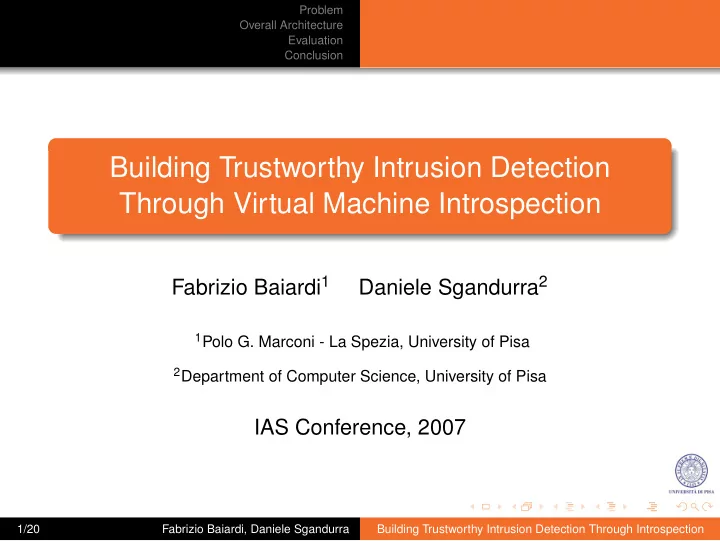

Problem Overall Architecture Evaluation Conclusion Building Trustworthy Intrusion Detection Through Virtual Machine Introspection Fabrizio Baiardi 1 Daniele Sgandurra 2 1 Polo G. Marconi - La Spezia, University of Pisa 2 Department of Computer Science, University of Pisa IAS Conference, 2007 1/20 Fabrizio Baiardi, Daniele Sgandurra Building Trustworthy Intrusion Detection Through Introspection
Problem Overall Architecture Evaluation Conclusion Outline Problem 1 Attacks and Evasion of Controls Overall Architecture 2 Virtual Machine Introspection Psyco-Virt Evaluation 3 Security Evaluation Performance Conclusion 4 Results and Future Works 2/20 Fabrizio Baiardi, Daniele Sgandurra Building Trustworthy Intrusion Detection Through Introspection
Problem Overall Architecture Attacks and Evasion of Controls Evaluation Conclusion Rootkits Rootkits have become more sophisticated over the years. User-level rootkits: usually, modify system binaries. Kernel-level rootkits: for example, a module inserted into the kernel. Unfortunately, rootkits and IDSes work at the same level. A rootkit can attack or evade the IDS controls. 3/20 Fabrizio Baiardi, Daniele Sgandurra Building Trustworthy Intrusion Detection Through Introspection
Problem Overall Architecture Virtual Machine Introspection Evaluation Psyco-Virt Conclusion Proposed Approach Virtual Machine Introspection: Standford University. Visibility: access VM’s state from a lower level. Robustness: detect intrusions from another VM. 4/20 Fabrizio Baiardi, Daniele Sgandurra Building Trustworthy Intrusion Detection Through Introspection
Problem Overall Architecture Virtual Machine Introspection Evaluation Psyco-Virt Conclusion Semantic Problem How to detect intrusions/attacks inside the VM? Semantic problem: the data accessed through introspection are raw data. We also need to protect the IDS. 5/20 Fabrizio Baiardi, Daniele Sgandurra Building Trustworthy Intrusion Detection Through Introspection
Problem Overall Architecture Virtual Machine Introspection Evaluation Psyco-Virt Conclusion Solution #1 Modify an IDS to work at the hardware level. 6/20 Fabrizio Baiardi, Daniele Sgandurra Building Trustworthy Intrusion Detection Through Introspection
Problem Overall Architecture Virtual Machine Introspection Evaluation Psyco-Virt Conclusion Solution #2 Build a complex introspection library to export an OS view of the VM’s state. 7/20 Fabrizio Baiardi, Daniele Sgandurra Building Trustworthy Intrusion Detection Through Introspection
Problem Overall Architecture Virtual Machine Introspection Evaluation Psyco-Virt Conclusion Our Solution: a Multi-Level Approach Build a simple introspection library to check the kernel. 1 Extend the kernel to monitor the IDSes inside the 2 monitored VM. Use standard IDSes to detect attacks against the VM. 3 8/20 Fabrizio Baiardi, Daniele Sgandurra Building Trustworthy Intrusion Detection Through Introspection
Problem Overall Architecture Virtual Machine Introspection Evaluation Psyco-Virt Conclusion Chain of Trust 9/20 Fabrizio Baiardi, Daniele Sgandurra Building Trustworthy Intrusion Detection Through Introspection
Problem Overall Architecture Virtual Machine Introspection Evaluation Psyco-Virt Conclusion Psyco-Virt Architecture Psyco-Virt merges Host and Network IDSes with VMI. The first prototype is written in C, based on Xen. Introspection VM: monitors all the VMs. Monitored VM: executes the system to be monitored. Control Network: to exchange the alerts and commands among the VMs. 10/20 Fabrizio Baiardi, Daniele Sgandurra Building Trustworthy Intrusion Detection Through Introspection
Problem Overall Architecture Virtual Machine Introspection Evaluation Psyco-Virt Conclusion Introspection VM Introspection VM: monitors all the VMs. The introspector protects kernel integrity. The director: collects the alerts; 1 executes actions in response to an alert: stops a VM. 2 11/20 Fabrizio Baiardi, Daniele Sgandurra Building Trustworthy Intrusion Detection Through Introspection
Problem Overall Architecture Virtual Machine Introspection Evaluation Psyco-Virt Conclusion Monitored VM Monitored VM: executes the system to be monitored. Runs IDSes to detect attacks/intrusions. The collector receives all the alerts from the local IDSes. The kernel checks IDS integrity. 12/20 Fabrizio Baiardi, Daniele Sgandurra Building Trustworthy Intrusion Detection Through Introspection
Problem Overall Architecture Virtual Machine Introspection Evaluation Psyco-Virt Conclusion Control Network Control Network: to exchange the alerts and commands among the VMs. 13/20 Fabrizio Baiardi, Daniele Sgandurra Building Trustworthy Intrusion Detection Through Introspection
Problem Overall Architecture Security Evaluation Evaluation Performance Conclusion Attacks Detected Currently, Psyco-Virt detects: Attacks to the kernel code also those inserting a malicious module. Udpates to the IDT and syscall table. Updates to the text area of a critical processes. Replacing ps and lsof. Interfaces set into promiscuous mode. 14/20 Fabrizio Baiardi, Daniele Sgandurra Building Trustworthy Intrusion Detection Through Introspection
Problem Overall Architecture Security Evaluation Evaluation Performance Conclusion IOzone Read Performance Overhead is less than 10%. 15/20 Fabrizio Baiardi, Daniele Sgandurra Building Trustworthy Intrusion Detection Through Introspection
Problem Overall Architecture Security Evaluation Evaluation Performance Conclusion IOzone Write Performance Overhead is less than 10%. 16/20 Fabrizio Baiardi, Daniele Sgandurra Building Trustworthy Intrusion Detection Through Introspection
Problem Overall Architecture Security Evaluation Evaluation Performance Conclusion Antisniff Antisniff implemented as a module or through introspection. 17/20 Fabrizio Baiardi, Daniele Sgandurra Building Trustworthy Intrusion Detection Through Introspection
Problem Overall Architecture Results and Future Works Evaluation Conclusion Limitations Current limitations of the prototype: No checks on kernel dynamic data, such as stack. Other critical kernel data structures, besides IDT and syscall table, have to be protected. Attacks to the VMM. Attacking the kernel between each execution of the checks. 18/20 Fabrizio Baiardi, Daniele Sgandurra Building Trustworthy Intrusion Detection Through Introspection
Problem Overall Architecture Results and Future Works Evaluation Conclusion Results Using unmodified IDSes with virtual machine introspection. Preventing evasion of the controls and attacks to IDSes. Multi-Level approach to form a chain of trust: IDSes. 1 Kernel. 2 VMM. 3 Acceptable overhead. 19/20 Fabrizio Baiardi, Daniele Sgandurra Building Trustworthy Intrusion Detection Through Introspection
Problem Overall Architecture Results and Future Works Evaluation Conclusion Future Works Checking at runtime memory invariants. Using abstract interpretation of kernel code. Tracing a VM, such as using ptrace. Verifying system call parameters. Using introspection as an attestation of the VM. Attesting the software to a remote party. 20/20 Fabrizio Baiardi, Daniele Sgandurra Building Trustworthy Intrusion Detection Through Introspection
Recommend
More recommend